Entries in wind contract (17)
11/7/11 Look what they've done to our fields, Ma: Wisconsin's newest wind project as seen from the air AND Wind developers in Illinois are no better
THE VIEW FROM ABOVE: FARM FIELD FRAGMENTATION IN WE ENERGIES GLACIER HILLS WIND PROJECT IN COLUMBIA COUNTY, WISCONSIN.
Photos by Jim Bembinster
Photo by Jim Bembinster, Columbia County WI 2011
NOTE FROM THE BPWI RESEARCH NERD: Wisconsin farmers sign on with wind developers because it seems like easy money. They are told they can farm right up to the turbine foundations. They are told about a quarter acre of land will be taken out of production for each turbine.
What they are not told is there will be access roads and trenching for each turbine that will go where the developer wants them to go, crossing at diagonals in the middle of fields, and in some areas compacting the soil so badly crop production is affected and drain tiles are crushed. The farmer is not told that the they've given the wind company the right to use the land as it wishes. It's all in the contract, if you know how to read a contract, or take that contract to a lawyer to read over for you.
The photos below were recently taken by Jim Bembinster. They show a wind project in Columbia County being built by We Energies and the newly fragmented farm fields.
To see larger versions of these pictures CLICK HERE
Better Plan will be posting more photos by Jim Bembinster of the Columbia County We Energies wind project in upcoming days

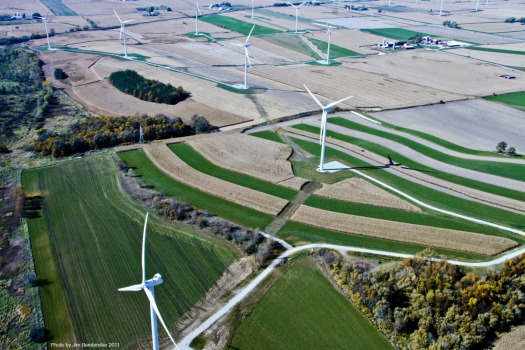
 Photo by Jim Bembinster, 2011 We Energies Glacier Hills wind project, Columbia County WI
Photo by Jim Bembinster, 2011 We Energies Glacier Hills wind project, Columbia County WI
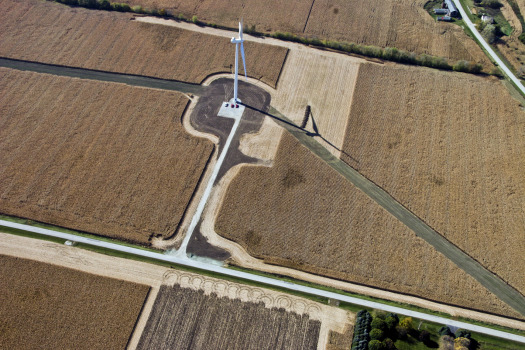
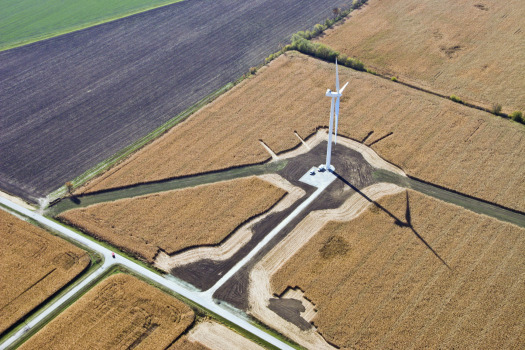

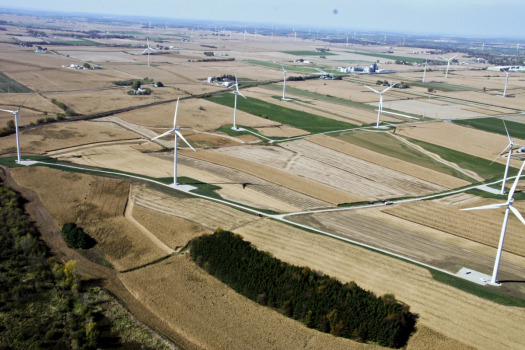
FROM ILLINOIS
FARMER UPSET WITH WIND COMPANY
BY DAVID GIULIANI, www.saukvalley.com 7 November 2011 ~~
COMPTON – Gale Barnickel, a Compton farmer, says he’s not against the wind farm being built in his area.
He and his parents decided against having turbines on their farm, but he said they respected the rights of others to have them.
“We have no problems with what the neighbors want,” he said.
Now, he is alleging that wind energy company Goldwind USA has been repeatedly trespassing on his family’s property. And that has resulted in crop damage, he said.
The property is well posted, he said, so trespassers knew what they were doing.
He brought the allegations to last week’s meeting of the county Zoning Board of Appeals, which is recommending changes to the county’s wind energy ordinance.
On Sunday, Goldwind admitted that its contractor mistakenly crossed into Barnickel’s land.
“When they realized this, they contacted Mr. Barnickel to apologize and address the issue,” spokesman Colin Mahoney said in a statement.
Since then, he said, the contractor has taken “concrete steps” to clearly mark Barnickel’s land, so it’s more visible to construction crews.
At last week’s meeting, those attending expressed concern about Barnickel’s situation. Another wind company weighed in, saying such things shouldn’t happen.
Goldwind, a subsidiary of a Chinese company, is putting up 71 turbines in an area of roughly 6 square miles near Compton in eastern Lee County. It hopes to finish the project – known as Shady Oaks – by year’s end.
In September, a farmer reported that the company had built a road through his cornfield that, he said, was unnecessary. He and another farmer pointed out roads and easements that, they contend, the company mistakenly built through faulty planning.
Other paths for transmission lines were curved, when a straight line would have taken out less cropland, they said.
Unlike Barnickel, those farmers allowed wind turbines on their property, which means they’ll get money every year from the company. In the contracts, Goldwind has agreed to compensate farmers for cropland lost in the construction project.
Barnickel has no agreement with Goldwind.
“Something has to be done to control these guys,” he said. “We try to be neighborly, but we’ve caught them mowing down our crops. They’re cutting corners wherever they can.”
Board member Tom Fassler asked Barnickel whether he had called authorities. The farmer said he had filed two reports with the Lee County Sheriff’s Department, but that it was a waste of taxpayers’ money to keep calling out the sheriff.
“It’s nerve-wracking being pushed around,” Barnickel said. “Why should I have to put up with that?”
“You shouldn’t,” Fassler responded.
Franklin Grove Village President Bob Logan, who attended the Zoning Board meeting, said that was what happens when wind farms are rushed through.
“You’re seeing the rush in the southern part of the county,” he said.
Logan warned that the county may face class-action lawsuits because “rights aren’t being respected.”
“It’s not a level playing field,” he said. “We are here to level it.”
John Martin of Mainstream Renewable Power, which plans a three-county wind farm, told Barnickel that “it’s just not right. No company should operate like this.”
The next day, Barnickel’s wife, Christina Barnickel, said in an interview that the state should fine companies that trespass.
“We have tried to stop them and showed them where the property line is,” she said. “You put so much hope and investment in the crop, and then someone knocks it over. It rubs you wrong.”
Mahoney said the company would continue to work hard to make sure it is a responsible neighbor throughout the rest of the project. He noted that the project is complex, with more than 100 workers busy building access roads, erecting turbines and delivering components on site.
“Despite this complexity, Goldwind is committed to minimizing the impact on the local community, including both participating landowners and neighboring landowners alike.”
NEXT FEATURE:
FROM WISCONSIN
More images of field fragmentation in the Columbia County We Energies wind project.
Photos by Jim Bembinster, 2011
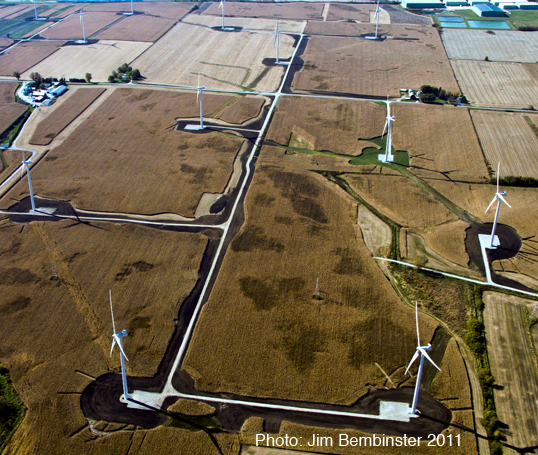
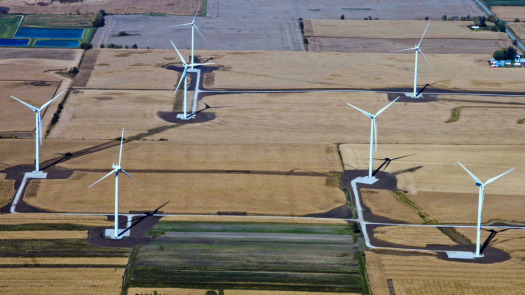
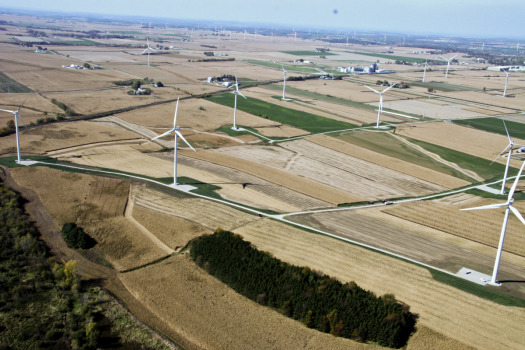
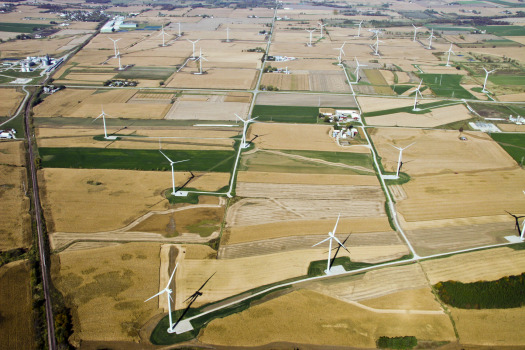
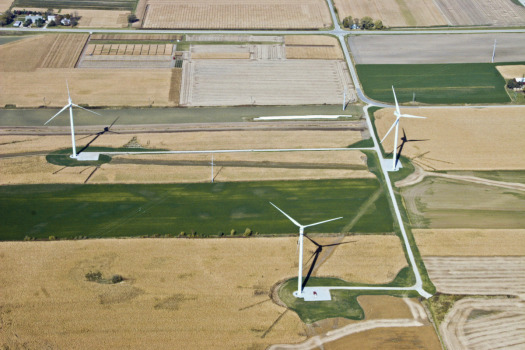

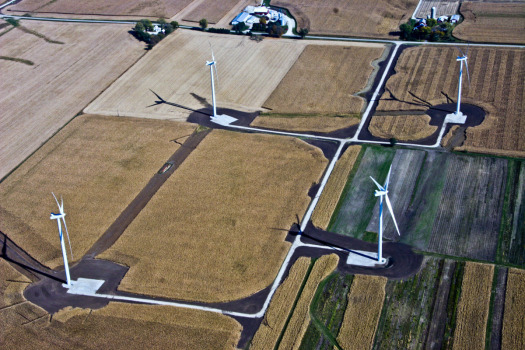

6/3/11 First comes the wind developer, then comes the met tower, then comes a lifetime of regret AND About that new wind developer poking around Spring Valley
 AN OPEN LETTER FROM A WISCONSIN FARMER WHO REGRETS SIGNING A WIND CONTRACT
AN OPEN LETTER FROM A WISCONSIN FARMER WHO REGRETS SIGNING A WIND CONTRACT
"By signing that contract, I signed away the control of the family farm, and it's the biggest regret I have ever experienced and will ever experience."
-Gary Steinich, Cambria, Wisconsin. June 2011
Sometime in late 2001 or early 2002, a wind developer working for Florida Power and Light showed up near the Wisconsin Town of Cambria looking to get in touch with someone at the Steinich family farm.
He wanted to talk to the landowner about leasing a bit of land for the installation of a met tower. He needed to measure the winds in the area for a possible windfarm and Walter Steinich's land looked like a good place to do it.
The wind developer seemed like a good guy to Mr. Steinich who was in his early 70's at the time. The money seemed good. A met tower didn't seem like a big deal. It was just a tall pole with some guy wires, and it was temporary. Mr. Steinich signed the contract.
That was nearly ten years ago. Mr. Steinich has since passed away and now his son, Gary, runs the farm. He's written an open letter to Wisconsin farmers about his experience with the wind company since then.
Photos below are of access roads and turbine foundations in various farm fields in the Glacier Hils project now under construction in Columbia County, Wisconsin
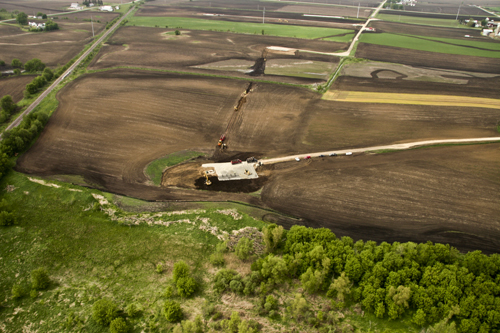 Turbine access road cutting diagonally across field in Glacier Hills project. May 2011
Turbine access road cutting diagonally across field in Glacier Hills project. May 2011
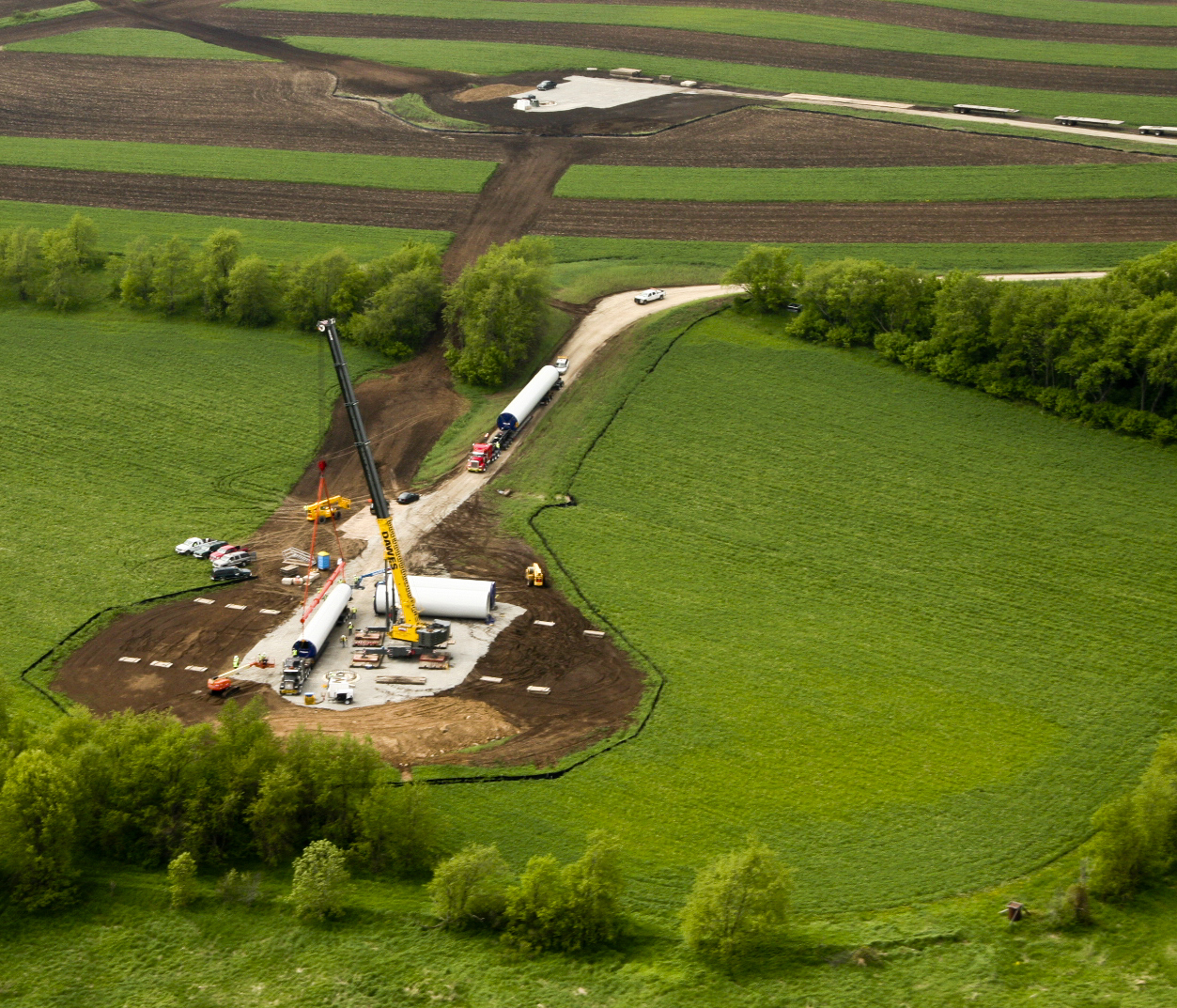
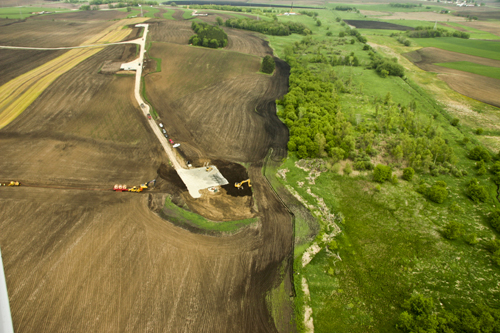
From One Wisconsin Farmer to Another:
This is an open letter to Wisconsin farmers who are considering signing a wind lease to host turbines on your land. Before you sign, I’d like to tell you about what happened to our family farm after we signed a contract with a wind developer.
In 2002, a wind developer approached my father about signing a lease agreement to place a MET tower on our land. My father was in his 70’s at the time. The developer did a good job of befriending him and gaining his trust.
He assured my father that the project wasn’t a done deal and was a long way off. They first had to put up the MET tower to measure the wind for awhile.
He told my father that if the project went forward there would be plenty of time to decide if we wanted to host turbines on our farm. There would be lots of details to work out and paperwork to sign well before the turbines would be built. The developer said my father could decide later on if he wanted to stay in the contract.
In 2003 the developer contacted us again. This time he wanted us to sign a contract to host turbines on our land. We were unsure about it, so we visited the closest wind project we knew of at the time. It was in Montfort, WI.
The Monfort project consists of 20 turbines that are about 300 feet tall and arranged in a straight line, taking up very little farmland with the turbine bases and access roads. The landowners seemed very satisfied with the turbines. But we were still unsure about making the commitment.
We were soon contacted again by the developer, and we told him we were undecided. Then he really started to put pressure on us to sign.
This was in March of 2004, a time of $1.60 corn and $1200 an acre land. It seemed worth it have to work around a couple of turbines for the extra cash. We were told the turbines would be in a straight line and only take up a little bit of land like the ones in Monfort.
And we were also told that we were the ones holding up the project. That all of our neighbors had signed, and we were the last hold-outs. It persuaded us.
What we didn’t know then was the developer was not being truthful. We were not the ‘last hold-out’ at all. In later discussions with our neighbors we found out that in fact we were the very first farmers to sign up. I have since found out this kind of falsehood is a common tactic of wind developers.
My father read through the contract. He said he thought it was ok. I briefly skimmed through it, found the language confusing, but trusted my father's judgment. We didn’t hire a lawyer to read it through with us. We didn’t feel the need to. The developer had explained what was in it.
The wind contract and easement on our farm was for 20 years. By then my dad was 75. He figured time was against him for dealing with this contract in the future so we agreed I should sign it. A few months later, my father died suddenly on Father's Day, June 20th, 2004
After that, we didn’t hear a whole lot about the wind farm for a couple years. There was talk that the project was dead. And then in 2007 we were told the developer sold the rights to the project. A Wisconsin utility bought it.
After that everything changed. The contract I signed had an option that allowed it to be extended for an additional 10 years. The utility used it.
The turbines planned for the project wouldn’t be like the ones in Monfort. They were going to be much larger, 400 feet tall. And there were going to be 90 of them.
They weren’t going to be in a straight row. They’d be sited in the spots the developer felt were best for his needs, including in middle of fields, with access roads sometimes cutting diagonally across good farm land. Landowners could have an opinion about turbine placement but they would not have final say as to where the turbines and access roads would be placed. It was all in the contract.
Nothing was the way we thought it was going to be. We didn't know how much land would be taken out of production by the access roads alone. And we didn't understand how much the wind company could do to our land because of what was in the contract..
In 2008 I had the first of many disputes with the utility, and soon realized that according to the contract I had little to no say about anything. This became painfully clear to me once the actual construction phase began in 2010 and the trucks and equipment came to our farm and started tearing up the field.
In October of 2010 a representative of the utility contacted me to ask if a pile of soil could be removed from my farm. It was near the base of one of the turbines they were putting on my land. I said no, that no soil is to be removed from my farm.
The rep said that the pile was actually my neighbor’s soil, that the company was storing it on my land with plans to move it to another property.
Shortly afterwards I noticed the pile of subsoil was gone.
In November of 2011 I saw several trucks loading up a second pile of soil on my land and watched them exiting down the road. I followed them and then called the Columbia County Sheriff. Reps from the company were called out. I wanted my soil back.
A few days later the rep admitted they couldn’t give it back to me because my soil was gone. It had been taken and already dispersed on someone else's land. I was offered 32 truck loads of soil from a stockpile they had. I was not guaranteed that the soil would be of the same quality and composition as the truck loads of soil they took from my farm.
I was informed by the lawyer for the utility that I had until April 30, 2011 to decide to take the soil. There would be no other offer. Take it or leave it.
I contacted the Public Service Commission for help. The PSC approved the terms of project and I believed the utility was violating those terms. The PSC responded by telling me they could do nothing because the issue involved a private contract between myself and the utility.
They told me my only option was to sue the utility.
My father and I both worked those fields. Watching the way they’ve been ripped apart would sicken any farmer. But what farmer has the time and money it would take to sue a Wisconsin utility?
By signing that contract I signed away the control of the family farm, and it’s the biggest regret I have ever experienced and will ever experience. I have only myself to blame for not paying close enough attention to what I was signing.
We had a peaceful community here before the developer showed up, but no more. Now it’s neighbor against neighbor, family members not speaking to one another and there is no ease in conversation like in the old days. Everyone is afraid to talk for fear the subject of the wind turbines will come up. The kind of life we enjoyed in our community is gone forever.
I spend a lot of sleepless nights wishing I could turn back the clock and apply what I've learned from this experience. Now corn and bean prices are up. The money from the turbines doesn't balance out our crop loss from land taken out of production. The kind of life we enjoyed on our family farm is gone forever too.
I would not sign that contract today. As I write this, the utility is putting up the towers all around us. In a few months the turbines will be turned on and we'll have noise and shadow flicker to deal with. If I have trouble with these things, too bad. I've signed away my right to complain. These are some of the many problems I knew nothing about when I signed onto the project.
If you are considering signing a wind lease, take the contract to a lawyer. Go over every detail. Find out exactly what can happen to your fields, find out all the developer will be allowed to do to your land. Go through that contract completely, and think hard before make your decision.
I can tell you from first hand experience, once you sign that contract, you will not have a chance to turn back.
Gary Steinich
Steinich Farms, Inc.
Cambria, WI
June, 2011
UPDATE: JUNE 5, 2011 Gary Steinich contacted Better Plan to let us know he and the utility have reached an agreement on his soil restoration.
EXTRA CREDIT READING:
It can be found on the PSC Docket for the Glacier HIlls project. [ #6634 CE 302]
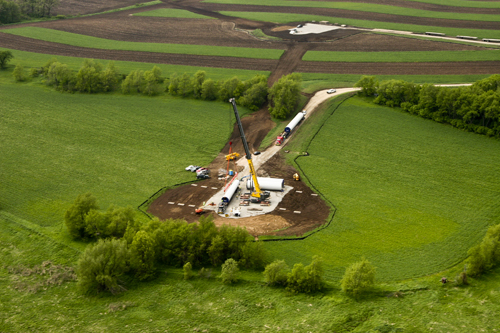
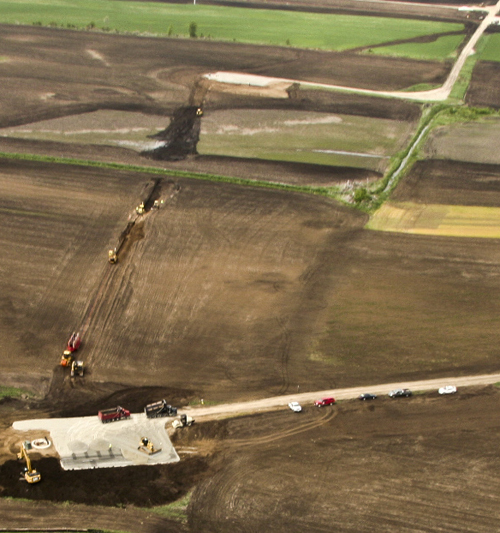
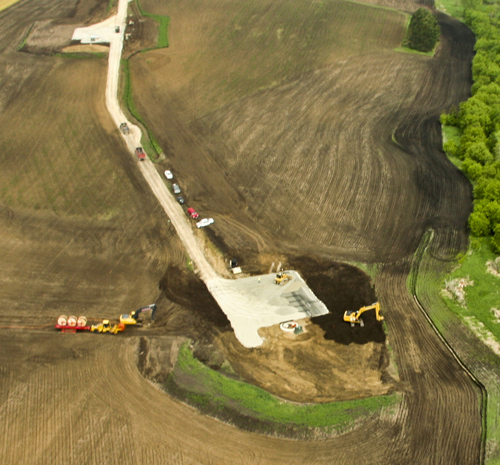
NEXT STORY: From Rock County, WI
SPRING VALLEY CONSIDERING BAN ON WIND TURBINES
SOURCE: The Janesville Gazette, gazettextra.com
June 4, 2011
By GINA DUWE
SPRING VALLEY TOWNSHIP — Town officials in Spring Valley are considering a new moratorium on wind turbines after the largest wind company in North America inquired about town wind ordinances.
The town board will discuss and likely vote on a moratorium at its Monday, June 13, meeting, Clerk Judy Albright said.
Spring Valley is among several area townships that wrote wind moratoriums while new rules to regulate wind projects less than 100-megawatts are decided at the state level.
Town officials discovered their previous moratorium expired Dec. 1 after Ted Weissman of NextEra Energy recently inquired about ordinances related to wind development and the process for placing a met tower.
A met tower gathers weather data to help wind developers determine if a site is good for development.
Weissman said he couldn’t comment but the company was looking at the area and hadn’t made any decisions. A company spokesman, however, said NextEra is not pursuing a met tower in Rock County.
Spokesman Steve Stengel said Weissman might have conducted some inquiries, but “we are not proposing it at this point,” he said. “What may or may not happen in the future (is) all speculation.”
NextEra owns and operates two wind farms in Wisconsin: 36 turbines at Butler Ridge Wind Energy Center in Dodge County and 20 turbines at Montfort Wind Energy Center in Iowa County.
Neighboring townships Magnolia and Union became possible sites for wind turbines a few years ago, and one met tower was placed in each town to gather data.
A spokeswoman for Acciona, the company that eyed those townships, said this week it is not pursuing “the early stage development project in Union and Magnolia. This enables (Acciona) to focus efforts and resources on other projects that are a better fit for their portfolio.”
Developers would be interested in hooking into the major transmission line that runs east-west through the northern part of Spring Valley, town officials said.
Smaller wind projects are permitted through local ordinances until lawmakers enact statewide rules.
Under state law, the Public Service Commission has to develop the rules, and a committee worked through most of last year to write the rules. When the rules were set to take effect in March, Republican lawmakers suspended them. It’s now up to legislators to approve new rules by May 2012 or the suspended rules would go into effect, a PSC spokesman said.
Republican Sen. Frank Lasee has proposed a bill that would add additional requirements to the PSC rules. The bill was referred to the Committee on Energy, Biotechnology and Consumer Protection, but no hearing is scheduled.
If you go
The town board will discuss and likely vote on a wind moratorium at its 7 p.m. meeting Monday, June 13, at the Orfordville Fire Department, 173 N. Wright St., Orfordville.
5/31/10 Which part of "negligently, carelessly and recklessly" don't you understand? Order in the courtroom, here comes the judge: wind farm residents file suit and want a jury trial AND Wind developers behaving badly: Mourning the presence of a level playing field for landowners
HAVE YOU REACHED OUT AND TOUCHED YOUR PSC TODAY?
The PSC is asking for public comment on the recently approved draft rules for siting wind turbines in our state. The setback recommended in this draft is 1250 feet from non-participating homes.
CLICK HERE and type in docket number 1-AC-231 to read what's been posted so far.
CLICK HERE to leave a comment on the Wind Siting Council Docket
Residents sue wind companies
HURON COUNTY — Citing a loss of property value and quality of life as a result of the Ubly area Michigan Wind I development, 16 Huron County residents filed a lawsuit earlier this month against the wind project’s various companies.
According to the lawsuit, which was filed May 11 in Huron County Circuit Court against John Deere Renewables, Deere & Company (John Deere), Noble Environmental Power, LLC, Michigan Wind I, LLC (Noble Thumb Windpark I) and RMT, Inc., the plaintiffs are seeking in excess of $25,000 and an injunctive relief ordering the companies to cease and desist their activities.
The defendants and plaintiffs
Plaintiffs listed on the lawsuit are David Peplinski, Marilyn Peplinski, Frank Peplinski, Georgia Peplinski, Terry Peplinski, Christine Peplinski, Curtis Watchowski, Lynda Watchowski, James Czewski, Delphine Czewski, Dennis Mausolf, Darcy Mausolf, Dale Laming, Elaine Laming, Lynn Sweeney, Pam Sweeney, Alger Nowak, Mary Nowak, Randy Weber and Angela Weber.
Though the complaints have been discussed in numerous meetings, there still is no complaint resolution at the county level — something that’s upset many. County officials, however, have said the board of commissioners soon will have a complaint resolution process in place.
Plaintiffs, during previous meetings, also have asked the county to amend its wind zoning ordinance so others in the future are not negatively affected as they say they have been.
According to records from the Huron County Clerk’s Office, all but four of the plaintiffs were part of a petition submitted in October 2005 that contained 1,846 signatures and asked for a review of the wind overlay zoning amendment, which was adopted by the county in the summer of 2005.
“We are simply trying to protect those people without contracts with the wind companies, those people who will not benefit in any way from the wind turbines — but who will have to live with the turbines for years to come,” said Angela Weber in a press release Residents for Sound Economics and Planning (RSEP) issued when the petition was submitted.
At the time RSEP submitted the petition to Huron County Clerk Peggy Koehler, the group claimed it was not an attempt to stop a wind park from being developed in the Ubly area. Instead, it was intended to create “better and more fair zoning for all citizens of Huron County,” according to a statement the group issued in October 2005. The issue ended up in court, as RSEP sued Koehler in November 2005 because she determined the petitions submitted by the group were inadequate. Circuit Court Judge M. Richard Knoblock ruled in favor of the county clerk.
Noble Environmental Power, LLC then proceeded with the development of Michigan Wind I, which consists of 42 turbines and encapsulates more than 150 parcels owned by 96 different landowners.
The project was sold to John Deere Wind Energy in October 2008, and the park officially went into commercial operation a few months later.
That’s when the plaintiffs state the quality of their life and property values began diminishing.
Count I: Private nuisance
In their lawsuit, the plaintiffs claim they have property rights and privileges with respect to the use and enjoyment of their property, and the defendants interfered with those rights by creating, through the operation of the wind farm, “significant and material intrusions upon the plaintiffs’ property.”
Intrusions detailed in the lawsuit include: • Low frequency noise and subaudible infrasound and/or impulse noise created by and emitted from the wind turbines, which range as close as 1,100 and 1,700 feet away from each plaintiff’s home.
• Sustained and highly disturbing audible noise created by the wind turbines.
• Amplitude modulation in both audible and sub-audible frequency ranges emitted from the turbines.
• A flicker/strobe light effect that covers the plaintiffs’ properties when sunlight passes through the rotating turbine blades.
The lawsuit states the interference and invasions caused by the conduct of the wind energy companies was either intentional and unreasonable, or unintentional and negligent conduct.
“The intrusions caused by the turbines in the wind farm cause plaintiffs actual physical discomforts and would cause such physical discomfort to a person of ordinary sensibilities,” the lawsuit states.
Physical harm and negative health effects listed in the lawsuit included: Inability to sleep and repeated awakening during sleep, headaches, dizziness, stress and tension, extreme fatigue, diminished ability to concentrate, nausea, and other physiological and cognitive effects.
The lawsuit notes the symptoms experienced by David and Marilyn Peplinski’s family forced them to rent an apartment away from the wind farm in order to avoid the adverse health effects.
“Despite the conditions caused by the continued operation of the wind farm and the resulting health conditions suffered by the plaintiffs, John Deere, John Deere Renewables and Michigan Wind I continue to operate and/or profit from the wind farm,” the lawsuit states.
Count II: Public nuisance
“Based on the aforementioned allegations, the actions of (the defendants) constitute an unreasonable interference with a common right enjoyed by the general public, including plaintiffs,” the lawsuit states. “Said actions resulted in the existence or creation of a dangerous condition to plaintiffs and other members of the general public and further resulted in significant harm to plaintiffs.”
In the portion of the lawsuit alleging the local wind park is a public nuisance, the lawsuit states the plaintiffs suffered harm and personal injuries different from the harm suffered by the general public, specifically, the increased harm to their health and well being that resulted from the close proximity of the turbines to their primary residences.
“The actions of (the defendants) further created a nuisance in fact, which was either intentional or negligent, by causing a hazardous or dangerous situation,” the lawsuit states.
Count III: Negligent design of wind farm
The lawsuit claims the wind companies had a duty to use reasonable care in the design and construction of the wind farm, specifically in relation to selecting turbine locations.
That duty was breached by the defendants, the lawsuit claims, because the companies ignored available data regarding the probability of negative health effects associated with placing the turbines in close proximity to the plaintiffs’ homes.
Also, the lawsuit references a noise assessment included in the project’s site plan review application that estimated only audible noise levels within the dBA range, and did not consider low frequency noise or impulse noise.
The lawsuit cites portions of the noise assessment stating, “in general, it is undesirable for any home, particularly that of a non-participant, to be on or inside a 45 dBA contour,” and “the probability of complaints from any project opponent exposed to this project noise level would be extremely high.”
Turbine noise measured at four of the plaintiffs’ homes ranged from 45 to 51 dBA, according to results from a noise study paid for by John Deere last fall that are included in the lawsuit.
The lawsuit claims the wind companies “negligently, carelessly and recklessly” sited the wind turbines in a way that increased the negative health effects and other damages. Other allegations state the wind companies negligently, carelessly and recklessly failed to construct the turbines at a safe distance from the plaintiffs’ residences, and to exercise reasonable care to prevent an unsafe condition and unreasonable risk of harm.
Count IV: Negligent misrepresentation
The lawsuit claims the wind companies made false representations in board of commissioner and planning commissioner meetings and public hearings when company representatives said the wind farm’s operations would not result in a noise nuisance or cause adverse health effects to adjacent landowners.
“(The defendants) were negligent in making these misrepresentations because, as the parties seeking approval to construct a wind turbine farm in Huron County, they had a duty to use reasonable care to provide Huron County and its citizens with both accurate and complete information,” the lawsuit states.
The plaintiffs claim the wind companies provided inaccurate and/or incomplete information about the audible turbine noise levels, and no information about low frequency noise, infrasound and/or impulse noise emitted from the turbines.
Huron County relied on the information from the wind companies when approving the project, the lawsuit states.
“(The defendants) should have known that the information it supplied to Huron County would directly impact the residents of Huron County, including plaintiffs,” the lawsuit adds.
Suit does not name any government entity
According to the Huron County Clerk’s Office, there have been no lawsuits filed against any government entities relating to any Thumb area wind park.
In the lawsuit against the wind companies, the plaintiffs are being represented by Craig W. Horn, of Braun Kendrick Finkbeiner, P.L.C. in Saginaw. Despite numerous attempts, Horn was unavailable for comment as of press time.
Ken Golden, Deere & Company Strategic Public Relations director, on Friday told the Tribune: “By company policy, Deere & Company does not make comment on pending litigation.”
The defendants have 28 days from the May 11 filing date to respond to the complaint, and then a hearing date will be scheduled, according to the Huron County Circuit Court Office.
The lawsuit states the plaintiffs have demanded a jury trial.
SECOND FEATURE: ANOTHER CHAPTER OF "WIND DEVELOPERS BEHAVING BADLY"
The following is a candid quote from an article in Renewable Energy World Magazine which outlines current difficulties faced by wind developers.
Wind Farms: Are All the Best Spots Taken?
“Another problem is that landowners have become increasingly savvy about the value of their property.
Farmers are driving harder bargains with wind developers for purchase or lease of their land.
A decade ago 'nobody knew what a fair price was, but as long it was not a dollar less than the guy down the road, they thought it was fair.
Now with the internet and more awareness of what these terms and conditions are, it has leveled the playing field', said Jim Tynion, a partner with the law firm Foley & Lardner, where he is chair of the Energy Industry Team.”
5/17/10 QUADRUPLE FEATURE: The Doctor is In: Council member Dr. Jevon McFadden presents his findings on wind turbines and human health AND 'How Stuff Works' explains the concerns AND What's on the WSC docket AND A reporter talks about being wrong about Big Wind and 'eating the NIMBY stick'
WIND SITING COUNCIL MEETING
1:30 PM Monday MAY 17 2010 AT THE PSC
Public Service Commission Building
610 North Whitney Way
Madison, Wisconsin
Audio of the meeting will be broadcast from the PSC Website beginning at 1:30 CLICK HERE to visit the PSC website, click on the button on the left that says "Live Broadcast". Sometimes the meetings don't begin right on time. The broadcasts begin when the meetings do so keep checking back if you don't hear anything right at 1:30.

NOTE FROM THE BPWI RESEARCH NERD: For some, watching a Wind Siting Council Meeting is like watching paint dry. For others it's like watching people toss your future around in their hands. For the BPWI Research Nerd (who is working on a book about the experiences of wind farm residents in our state) it's a front row seat on the creation of siting standards that will either protect the people and avian species of our state, or protect the interests of wind developers, utilities and wind lobbyists. If you live in rural Wisconsin, there is a very good chance that this issue will soon be at your front door.
As we look over the agenda we look forward to discussion of the PSC commissioner's sudden adoption of draft rules last week.
On Friday, the PSC commissioners approved draft wind siting rules containing conditions which include specific numbers concerning setbacks and noise limits the Wind Siting Council has never been allowed to discuss.
For those of us following this issue, this sudden move by the PSC commissioners comes as a complete surprise.
The numbers used for the draft rules come from the Glacier Hills decision, according to the commission.
The setback from non participating homes in Glacier Hills is 1250 feet. The noise limit is 50 dbA and 45dbA depending on the season.
The setbacks and noise limits previdously approved by the PSC which causing so much trouble for residents in existing Wisconsin wind projects are 1000 feet from non participating homes and a noise limit of 50dbA.
AGENDA
MEETING NOTICE
Wind Siting Council
Docket 1-AC-231
Monday, May 17, 2010, beginning at 1:30 p.m.
Agenda
1) Welcome/Review of today’s agenda
2) Review and adoption of meeting minutes of April 29, 2010
3) Update on Commission rulemaking process
4) Presentation: Wind Turbines: A Brief Health Overview
Council member Jevon McFadden, MD, MPH
5) Next steps/Discussion of next meeting’s time, place and agenda
6) Adjourn
This meeting is open to the public.
If you have any questions or need special accommodations, please contact Deborah
Erwin at the Public Service Commission of Wisconsin by telephone at (608) 266-3905 or
via e-mail at deborah.erwin@wisconsin.gov.
SECOND FEATURE:
HAVE YOU REACHED OUT AND TOUCHED YOUR PSC TODAY?
The PSC is asking for public comment on the recently approved draft siting rules
CLICK HERE and type in docket number 1-AC-231 to read what's been posted so far.
CLICK HERE to leave a comment on the Wind Siting Council Docket
Here is a recent comment from a resident of Greenleaf, Wisconsin
I just read the last siting minutes and the draft document putting setbacks from non-participating residents at 3.1 X turbine height and "1.1" X turbine height from the property line.
In my case this is effectively stealing 690 feet of my property.
My neighbor has 138 acres and I have ten acres. If he doesn't have enough acreage to keep the 3.1 X setback from the "property line", then he does not have enough land host two turbines.
I paid off the mortgage for my land with the property rights intact and I paid the the property taxes on my land for 29 years. If there is anyone entitled to the property rights of my property- it is me.
If the state wishes to exercise eminent domain, then they have a right to do so for public conveyance and I must be compensated for the loss of my property.
The wind developer and my neighbor DO NOT have the right of eminent domain. The Wind Siting Council has a legal and moral obligation to respect the property rights of all Wisconsin property owners and any rules they make must reflect those obligations.
I affirm that these comments are true and correct to the best of my knowledge and belief.
Dave Hettmann
THIRD FEATURE
Do wind turbines cause health problems?
by Julia Layton
SOURCE: How Stuff Works
http://science.howstuffworks.com/wind-turbines-health.htm/printable
Some people living near wind turbines complain of chronic sleep loss, headaches and other symptoms
Wind power accounts for about 1 percent of the electricity produced in the United States [source: Gillam]. Nearly 25,000 wind turbines crank out power throughout the country. These massive windmills -- up to 80 feet (24 meters) tall -- capture the energy in wind and convert it into free-flowing electrons that people can use to run dishwashers, air conditioning and lights.
That 1 percent may not sound like much until you realize that wind power is just catching on in the United States. Huge new wind farms accounting for thousands more megawatts of capacity are in development as we speak, and estimates put 20 percent of the nation's electricity coming from wind power by 2030 [source: The Oregonian]. The European Union hopes to reach that percentage even sooner -- by 2020.
Until recently, there were three main issues regarding the possible downsides of wind power: bird and bat deaths, cost, and disrupting the appearance of natural landscapes. But a new objection to wind power has popped up in the past few years, resting on the research of a few scientists. The latest argument states that wind power endangers the health of people who live near windmills. Some people call this theory "wind-turbine syndrome." Although the extent of the phenomenon is unknown, there does seem to be something to it.
Those concerned about wind-power syndrome are interested in finding out if and how wind power could be making people sick. Is everyone living near windmills facing health problems? Let's take a look at the possible health risks associated with wind farms and find out whether we should be worried about the steady increase in wind-generated power throughout the world.
Infrasound and The Body
The rapidly spinning blades of huge wind turbines have an effect on their surroundings, and it goes beyond aesthetics. The blade tips of a wind turbine can spin at speeds of up to 80 meters per second, or about 180 miles per hour. In high winds, this rapid spinning can produce sound and vibration -- in addition to disruptions in air pressure [source: MIT].
The extremely low air pressure surrounding a wind turbine could be the reason why bats die near them. A bat's lungs are very delicate, and it seems the low pressure might cause them to expand to the point of bursting blood vessels [source: NewScientist]. Scuba divers can certainly attest to the effects of pressure on the human body.
And the corporeal effects of sound -- essentially fluctuations in air pressure that vibrate the eardrum -- are well-documented. For instance, infrasound -- sounds at such low frequency that they can't be picked up by the human ear but can carry through the atmosphere for thousands of kilometers -- is believed to cause certain breathing and digestive problems [source: Infrasound Lab].
Infrasound is the primary issue for those concerned about wind-turbine syndrome. They also say that audible sound and vibrations contribute to the health problems reported by some people who live close to wind farms. Symptoms of wind-turbine syndrome might include:
* headaches
* sleep problems
* night terrors or learning disabilities in children
* ringing in the ears (tinnitus)
* mood problems (irritability, anxiety)
* concentration and memory problems
* issues with equilibrium, dizziness and nausea
Around the World
As of May 2008, about 25,000 wind turbines are cranking out power across the country -- and the world [source: Gillam]. In Britain, 2,100 turbines supply up to 2 percent of the country's power; Germany, the world's top user of wind power, draws 7 percent of its electrical needs from more than 19,000 turbines [source: BBC,BWEA].
These symptoms have been observed and documented by a limited number of scientists studying small groups of people, and the scientific community hasn't concluded whether wind-turbine syndrome exists.
There are also mixed opinions on whether wind turbines emit infrasound and if the amount is any more than that emitted by diesel engines or waves crashing on the beach [source: CleanTechnica, ABC Science]. But we do know that at high speeds, wind turbines can produce an audible hum and vibration that can be carried through the air. It's these sounds and motions that provide clues and possible solutions to wind-turbine syndrome, which we'll explore in the next section.
Wind-Turbine Syndrome Explanations and Solutions
It's understood that some people who live in close proximity to wind turbines experience sleep disturbances, headaches and concentration problems. These symptoms and others could be explained as the effects of infrasound as well as constant humming and vibrations.
But here's the catch: Many of the symptoms of wind-turbine syndrome can also be caused by chronic sleep loss -- simply and unfortunately an effect of living near a noise-producing entity [source: Ohio Department of Health].
People who live near a highway or busy street may have trouble sleeping, which can lead to other health problems like irritability, anxiety, concentration and dizziness.
Infrasound Weapons
There was a rumor years ago about an infrasound-based military weapon that would make people lose control of their bowels and poop on themselves. It was said to be a riot-control device. The rumor wasn't true, as far as we know [source: ABC Science]. But in theory, such a weapon might work.
To solve this sound issue, new wind-power technology employs sound-dampening systems. Engineers are hoping that these newer systems -- which can block or cancel out multiple sound frequencies -- will reduce any sound-related problems associated with wind farm communities [source: Fraunhofer-Gesellschaft].
Researchers studying wind-turbine syndrome also recommend a larger buffer zone around wind farms to protect people from any ill effects. Some people say that the distance should be least 1.2 miles (2 kilometers) [source: CleanTechnica].
Others suggest at least 2 miles (3.2 kilometers) [source: PlanetGore].
Some wind farms are currently located as close as a half mile (0.8 kilometers) from residential areas.
Whether we should be concerned with the expansion in wind power ultimately comes down to weighing the pros and cons. Is cleaner, cheaper, domestically produced energy worth the potential side effects of some people experiencing headaches? The hope is that new buffer-zone regulations and sound-canceling technologies can do away with the question entirely.
If the issue persists, we'll have to decide whether wind power is important enough to pursue anyway -- much like deciding whether building a new, noisy highway that would reduce congestion and increase commerce is worth some unfortunate people losing sleep.
Sources
* ABC Science. Brown note: bad vibration mega-hurts. May 13, 2008.
http://www.abc.net.au/science/articles/2008/05
/13/2242923.htm?site=science/greatmomentsinscience
* BWEA.Low Frequency Noise and Wind Turbines.
http://www.bwea.com/ref/lowfrequencynoise.html
* CleanTechnica. Wind Turbines and… Health? August 18, 2008.
http://cleantechnica.com/2008/08/18/wind-turbines-and-health/
* "Anti-noise" silences wind turbines.
http://www.fraunhofer.de/EN/press/pi/2008/08/Research
News082008Topic3.jsp
* Gillam, Carey. Wind power gains adherents in United States. International Herald Tribune. Reuters.
http://www.iht.com/articles/2008/05/19/business/wind.php
* Infrasound Lab. University of Hawaii.
http://www.isla.hawaii.edu
* NewScientist Environment. Wind turbines make bat lungs explode. August 25, 2008.
http://environment.newscientist.com/article/dn14593
* Ohio Department of Health. Bureau of Environment Health. Health Assessment Section. Literature search on the potential health impacts associated with wind-to-energy turbine operations.
www.odh.ohio.gov/ASSETS/C43A4CD6C24B4F8493CB32D525FB7C2
7/Wind%20Turbine%20SUMMARY%20REPORT.pdf
* Planet Gore. Wind Turbine Syndrome. August 15, 2008.
http://planetgore.nationalreview.com/post/?q=YTgxZjc4NzMyM2YxYTNj
ZDI5YTNlY2E0YjVhOWNmMGU=
* The Oregonian. Wind whips up health fears. August 10, 2008.
http://www.oregonlive.com/news/oregonian/index.ssf?/base/news
/1218250522129010.xml&coll=7&thispage=1
* WindAction.org. Wind Turbine Syndrome. March 12, 2006.
http://www.windaction.org/pictures/2010
5/10/10 May 4th shadow flicker and turbine noise AND Next Wind Siting Council Meeting has been CANCELLED---AND Will Horton Hear a Who? AND What's on the WSC Docket Today?
Click on the images below to watch wind turbine shadow flicker in the 36 turbine Butler Ridge project in Dodge County, Wisconsin. Each turbine in this video is 400 feet tall. Filmed on the morning of May 4th, 2010 en route to a Wind Siting Council meeting hosted at the home of council member Larry Wusch who lives in the Invenergy Forward Energy project located about twenty miles north of Butler Ridge.
This turbine in this video emitted a high pitched whistle as well as low pulsing jet sounds.
This video shows how long the turbine shadows are, and what shadow flicker looks like when it covers a field, a house and a barn
 THE NEXT WIND SITING COUNCIL MEETING IS CANCELLED FOR 9AM WEDNESDAY MAY 12 2010 AT THE PSC
THE NEXT WIND SITING COUNCIL MEETING IS CANCELLED FOR 9AM WEDNESDAY MAY 12 2010 AT THE PSC
Public Service Commission Building
610 North Whitney Way
Madison, Wisconsin

NOTE FROM THE BPWI RESEARCH NERD: For some, watching a Wind Siting Council Meeting is like watching paint dry. For others it's like watching people toss your future around in their hands. For the BPWI Research Nerd (who is working on a book about the experiences of wind farm residents in our state) it's a front row seat on the creation of siting standards that will either protect the people and avian species of our state, or protect the interests of wind developers, utilities and wind lobbyists.
Will residents of Wisconsin wind projects be heard?
SPOILER ALERT: Because of the composition of the WSC , the Research Nerd predicts the interests of the wind developers, utilities, and wind lobbyists will win out over the protection of the people and bats and birds of rural Wisconsin who will be living with the fallout of wind development.
Unless--- by some miracle---the PSC Horton Hears a Rural Wisconsin Who.
If you'd like to make your voice heard, CLICK HERE to leave a public comment on the Wind Siting Council Docket. What you post will become public record. There is no limit to the number of posts you can make. You are free to post opinion, articles, documents, and video links. Anything that you would like the wind siting council to consider.
It's Better Plan's understanding that though some of the council members do pay attention to the docket, there is no requirement that the council read any of the posts.
WHAT'S ON THE WSC DOCKET TODAY?
This "energy sprawl" of giant turbines and pylons will require far greater amounts of concrete and steel than conventional power plants—figure on anywhere from 870 to 956 cubic feet of concrete per megawatt of electricity and 460 tons of steel (32 times more concrete and 139 times as much steel as a gas-fired plant).
From a review of "Power Hungry" by Robert Bryce SOURCE: The Wall Street Journal
ON THE WSC DOCKET: Better Plan thanks Curt Hilgenberg and Julie Bixby-Wendt for taking the time to post to the docket.
This Post from Curt Hilgenberg, Town of Holland, Brown County includes an article about wind power By Robert Bryce in the Wall Street Journal. The quote above is from Bruce's book, "Power Hungry", released in April.
March 1, 2010 by Robert Bryce in Wall Street Journal
People living near turbines increasingly report sleep deprivation, headaches and vertigo. The wind lobby says there's no proof
Imagine this scenario: The oil and gas industry launches an aggressive global drilling program with a new type of well. Thousands of these new wells, once operational, emit a noxious odor so offensive that many of the people living within a mile of them are kept awake at night. Some are even forced to move out of their homes. It's easy to predict the reaction: denunciations of the industry, countless lawsuits, and congressional investigations.
Now substitute wind for oil and gas and consider the noise complaints being lodged against wind projects around the world.
The Obama administration has made the increased use of wind power to generate electricity a top priority. In 2009 alone, U.S. wind generation capacity increased by 39%. But more wind power means more giant turbines closer to more people. And if current trends continue, that spells trouble.
In 2007, a phalanx of wind turbines were built around Charlie Porter's property in rural northern Missouri. Soon, Mr. Porter began to have trouble sleeping. So did his wife and daughter. The noise, he told me, made sleeping almost impossible. "We tried everything-earplugs, leaving the TV station on all night." Nothing worked. Late last year he moved his family off their 20-acre farm.
Mr. Porter's story is no isolated event. Rural residents in Texas, Maine, Pennsylvania, Oregon, New York, Minnesota, Wisconsin, Canada, New Zealand, Australia, France and England have been complaining about the noise from wind turbines, particularly about sleep deprivation.
Dozens of news stories-most of them published in rural newspapers-have documented the problem.
I've spoken to nine other people in New York, Wisconsin, Ontario, New Zealand, Nova Scotia and England who live, or lived, near wind turbines. All complained of the noise, with sleep deprivation being the most common complaint. For example, Janet Warren, who raises sheep near Makara, New Zealand, told me via email that the turbines near her home emit "continuous noise and vibration," which disturb her sleep and are causing "loss of concentration, irritability, and short-term memory effects."
Complaints about sleep disruption-as well as the deleterious health effects caused by the pulsing, low-frequency noise emitted by the giant turbines-are a central element of an emerging citizen backlash against the booming global wind industry.
Lawsuits that focus on noise pollution are now pending in Maine, Pennsylvania and New Zealand. In New Zealand, more than 750 complaints have been lodged against a large wind project near Makara since it began operating last April. The European Platform Against Windfarms lists 388 groups in 20 European countries. Canada has more than two dozen antiwind groups. In the U.S. there are about 100 such groups, and state legislators in Vermont recently introduced a bill that will require wind turbines be located no closer than 1.25 miles from any residence.
In theory, big wind projects should only be built in desolate areas. But the reality is that many turbines are being installed close to homes. Wind developers put a turbine within 550 meters of Mr. Porter's house. Hal Graham, a retired office manager in Cohocton, N.Y., complains about the noise pollution caused by a turbine 300 meters from his home. Tony Moyer, a plumbing superintendent in Eden, Wis., grumbles about the noise generated by three turbines built within 425 meters of his house.
Doctors and acoustics experts from the U.S. to Australia report a raft of symptoms that they blame on wind turbine noise, including sleep disturbance, headaches and vertigo. Dr. Nina Pierpont, a pediatrician in Malone, N.Y., has studied 36 people affected by wind turbine noise since 2004 at her own expense.
The people she interviewed were widely dispersed; they lived in the U.S., Canada, England, Ireland and Italy. She found that the collection of symptoms she calls "wind turbine syndrome" disappeared as soon as people moved out of their noise-affected homes and into new locations at least five miles from any turbines.
Across the border, Ontario-based orthopedic surgeon Dr. Robert McMurtry has been researching wind turbine noise for the past 18 months. Dr. McMurtry, a fellow of the Royal College of Physicians and Surgeons of Canada, counts more than 100 people in Ontario he believes are experiencing adverse effects from turbine noise. "It has compromised their health," he says.
The wind lobby has publicly rejected these claims. In December, the American Wind Energy Association in conjunction with the Canadian Wind Energy Association, issued a report titled "Wind Turbine Sound and Health Effects: An Expert Review Panel."
It declared: "There is no evidence that the audible or sub-audible sounds emitted by wind turbines have any direct adverse physiological effects." It also suggested that some of the symptoms being attributed to wind turbine noise were likely psychosomatic and asserted that the vibrations from the turbines are "too weak to be detected by, or to affect, humans."
Yet the report also noted that in "the area of wind turbine health effects, no case-control or cohort studies have been conducted as of this date." True enough-but it means there are no studies to prove or disprove the case. It also says that "a small number of sensitive people" may be "stressed" by wind turbine noise and suffer sleep deprivation. But who gets to define "sensitive" and "small number"? And if turbine noise and sleep disturbance aren't problems, then why are people in so many different locations complaining in almost identical ways? Such questions are only going to be pressed with more urgency in the future.
By 2030, environmental and lobby groups are pushing for the U.S. to produce 20% of its electricity from wind. According to the Department of Energy, meeting that goal will require the U.S. to have about 300,000 megawatts of wind capacity, an eightfold increase over current levels. Installing tens of thousands of new turbines inevitably means they'll be located closer to populated areas.
The health effects of low-frequency noise on humans are not well understood. The noise in question often occurs at, or below, decibel levels that are commonly considered a public nuisance. And detecting low-frequency noise requires sophisticated acoustic gear. For all of these reasons, this issue should be investigated. If policy makers are serious about considering all of the impacts of "green" energy, then an impartial, international study of the effects of wind turbine noise should be undertaken without delay.
Mr. Bryce is the managing editor of Energy Tribune. His fourth book, "Power Hungry: The Myths of 'Green' Energy and the Real Fuels of the Future," will be published in April by PublicAffairs.
Web link: http://online.wsj.com/article/SB100014240527487042...
POST TO THE WSC DOCKET FROM
Julie Bixby-Wendt
Greenleaf, Wisconsin
Submitted May 8, 2010
Below are my comments that I emailed to Fox 11 and other news stations, newspapers and State representatives:
I watched your story about the "Wind Wars" going on in the Town of Morrison. I am a resident of the town and wondered if you are aware that property owners who have vacant land next to a property owner who has signed an easement for a wind turbine are receiving absolutely no compensation, even though they are basically taking away 500 feet of our land at every side where a turbine will be placed, because the 1,000-foot setback is from a dwelling rather than the property line.
My husband and I own 40 acres of vacant land. There are proposed wind turbines on property next to at least two sides of our land, and they only have to be 500 feet away from our property.
We have kept this property with the intention that our children might someday build their homes on this land. Because any dwelling will have to be placed 1,000 feet away from a turbine, they are effectively taking away at least 500 feet of our land without any compensation to us.
If they make the setbacks from a dwelling larger, that will mean more of our property will be stolen from us. What happened to our encroachment rights?
Every time I hear someone say how much money this wind farm could bring to property owners, it makes me very upset!
I would like to hear someone reporting on how our state and the power companies are stealing from property owners and shoving these wind turbines down our throats! They should have to get a vote from a town as to whether or not they would like to host a wind farm before they can even come into a town and sneak around getting easements from anyone who will sign up.
Also, even though the people in our town have to live with the wind turbines, the town will receive less money than the county for having them here (town gets 1/3, county gets 2/3).
Even their sneaking around is underhanded.
We were approached to host a wind turbine and were told all of our neighbors were signing up so we might as well get in on the action. They even mentioned names of our neighboring property owners who had signed up, so we were somewhat interested...until I took the contract to an attorney who told me it was a terrible contract.
So now, because we are not hosting a turbine we are not receiving any money, and they are taking some of our land anyway because the setbacks are not the same from the property line as from a dwelling. This just isn't right!
Besides the actions our town is taking (apparently the state has made it impossible for a town to do much against wind turbines), we just don`t know who to contact who can help us, and others like us, who are being robbed.
I don`t know when alternative energy became more important than people, but our government is definitely not standing up for the people. If you have any suggestions as to where we can get help with this, it would be deeply appreciated!
I affirm that these comments are true and correct to the best of my knowledge and belief.
Julie Bixby-Wendt
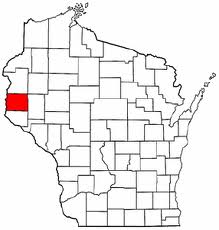
Want to keep up with what's going on with the wind siting council? For some it's like watching paint dry, for others it's watching people toss your future around in their hands
Remember to check the docket
Click here to visit the Public Service Commission of Wisconsin website
Type in Docket number 1-AC-231
WHAT'S THE LATEST ON THE DOCKET?
EXTRA CREDIT: Click on the image above to hear another wind turbine that whistles because of a faulty blade.
